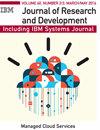通过PR/SM放置分区
IF 1.3
4区 计算机科学
Q1 Computer Science
引用次数: 0
摘要
IBM Z的每一代新机器都会带来物理处理器数量和内存容量的增加。某些代还可以更改服务器的物理配置。例如,z15可以有一到五个抽屉,而不是z14上最多四个抽屉。作为另一个例子,与z14上的每个节点两个或三个芯片相比,z15每个节点固定两个芯片。另一方面,逻辑分区可以有各种配置,包括“专用”逻辑分区、共享“Hiperdispatch=YES”逻辑分区和共享“Hierdispatch=NO”分区。每种分区类型都可以请求机器生成所允许的逻辑处理器和内存,这通常少于机器上可用的物理资源。给定物理服务器的配置,逻辑分区在物理服务器上的最佳位置是一个NP难题。内存访问延迟和缓存使用率在逻辑分区的性能中起着至关重要的作用,因此必须优化布局。此外,在z15上,除了已经允许移动的通用和IBMZ集成信息处理器之外,在分区布局的重新优化过程中,linux处理器和内部耦合设备处理器的集成设施可以从一个芯片移动到另一个芯片,这加剧了布局问题。本文描述了对z15的处理器资源/系统管理器(PR/SM)启发式布局算法所做的更改,以及它如何克服逻辑分区优化布局所固有的问题。本文章由计算机程序翻译,如有差异,请以英文原文为准。
Partition placement by PR/SM
Every new machine generation of IBM Z brings with it an increase in number of physical processors and memory capacity. Some generations can also bring change in the physical configuration of the server. The z15 for example, can have from one to five drawers instead of a maximum of four on the z14. As another example, z15 has fixed two chips per node versus the two or three chips per node on z14. The logical partitions on the other hand can come in various configurations, including “Dedicated” logical partition, shared “Hiperdispatch = YES” logical partition, and shared “Hiperdispatch = NO” partition. Each of the partition types can request as many logical processors and memory as the machine generation will allow, which is usually less than the physical resources available on the machine. The optimal placement of logical partitions on the physical server, given its configuration, is an NP-hard problem. Memory access latency and cache usage play vital roles in the performance of logical partitions, and it is imperative that placement is optimal. Moreover, on z15, the integrated facility for linux processors and internal coupling facility processors can be moved from one chip to another, during reoptimization of partition placement, in addition to general-purpose and IBM Z integrated information processors that are already allowed to be moved, compounding the placement problem. This article describes the changes made to the Processor Resource/Systems Manager (PR/SM) heuristic placement algorithm for z15 and how it surmounts the problems inherent for optimal placement of logical partitions.
求助全文
通过发布文献求助,成功后即可免费获取论文全文。
去求助
来源期刊

IBM Journal of Research and Development
工程技术-计算机:硬件
自引率
0.00%
发文量
0
审稿时长
6-12 weeks
期刊介绍:
The IBM Journal of Research and Development is a peer-reviewed technical journal, published bimonthly, which features the work of authors in the science, technology and engineering of information systems. Papers are written for the worldwide scientific research and development community and knowledgeable professionals.
Submitted papers are welcome from the IBM technical community and from non-IBM authors on topics relevant to the scientific and technical content of the Journal.
 求助内容:
求助内容: 应助结果提醒方式:
应助结果提醒方式:


